New Forest badgers
Introduction
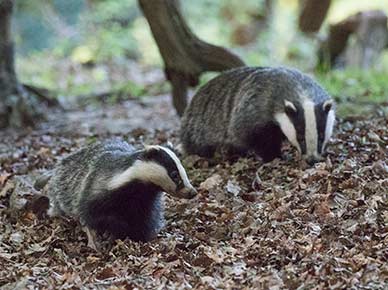
exploring the landscape around
their underground home
Badgers have roamed the New Forest since time immemorial, once sharing the woods with wolf, bear and wild boar. Indeed, badgers are often considered to have given Brockenhurst its name, and almost certainly did to Brockis Hill, near Minstead; and Brock Hill on the Rhinefield Ornamental Drive.
Badgers are absolutely unmistakable creatures. Conspicuously black and white about the head, badgers are of medium sized - 1 metre (3 feet), or so, long; very sturdy; and very low to the ground. The strikingly marked face shows clearly in the half-light, but the otherwise grey coat blends well with woodland shadows.
Badger guard hairs are very coarse – they were once used to make shaving brushes – and the tail is short. Front feet and claws are incredibly strong, evolved for digging out tunnel system homes. Large badger setts can contain more than 1,000 metres (3,280 feet) of tunnel constructed by countless generations of badgers, and have more than 80 entrances spread over a considerable area.
Unlike New Forest foxes, live badgers are rarely seen in daylight, or even at dusk away from the sett, preferring to stay indoors during the day, and close to home immediately after emergence when they groom, play, gather bedding to be pulled backwards down into a tunnel entrance, or simply potter about.
It seems, too, that badgers avoid paths used by humans, preferring their own well-trodden, narrow tracks through the woods, although they willingly come to garden feeding stations where they treat householders to prolonged views.
Most live badger sightings, though, are reserved for those prepared to sit quietly and wait by a sett for an appearance of these often mysterious creatures.
Badgers, bovine Tuberculosis (bTB), and the badger cull
a common sense view on an emotive subject
Badger Cull, featuring Chris Packham and Brian May
(it also contains information about
helping out on badger patrols)
An introduction to badgers (continued)
Badgers are sociable animals within their own family group, which itself might be spread about clusters of main and outlying setts. They even sometimes visit the relatives – individuals can disappear from home for days at a time, only to turn up at another sett nearby. Territorial aggression between badger groups is marked, however, as animals protect the food and other resources within their own home range.
Fastidiously clean animals, badgers sometimes groom alone soon after emerging from the sett, but families may often groom communally, two or more animals rolling on their backs or sitting on their haunches, scratching, licking, nibbling one another’s coats, before eventually going off to hunt.
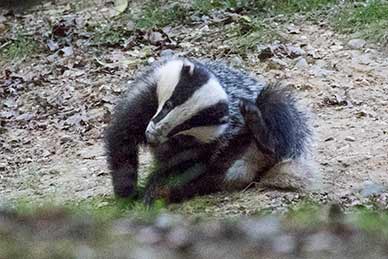
emergence from the sett
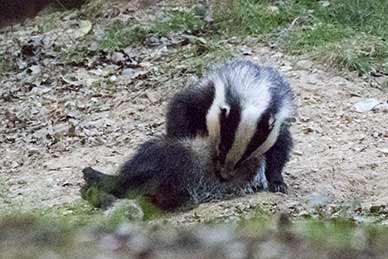
nibble starts proceedings
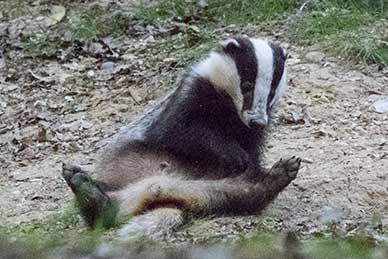
of cleaning those hard to reach places
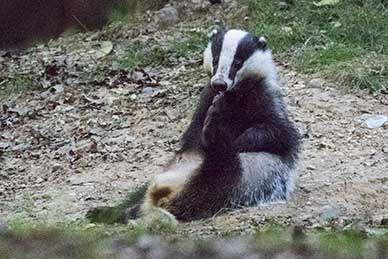
a good old scratch of the chin
Great care, too, is taken with toilet arrangements. Not for them the messy deposit of dung in any old place, for badgers use latrines. These shallow, specially dug pits are spread around the edges of the sett and located at strategic intervals along territorial boundaries where they serve to warn off intruders from other family groups.
Badgers are omnivorous feeders that will eat just about anything edible. Blackberries, grasses, invertebrates and, when available, birds’ eggs are all favourites. But they like nothing more than a hearty meal of earthworms. The typically acid New Forest soils, though, support relatively few of these spaghetti-like morsels, so for many badgers, particularly when the ground is dry, food is often relatively hard to find.
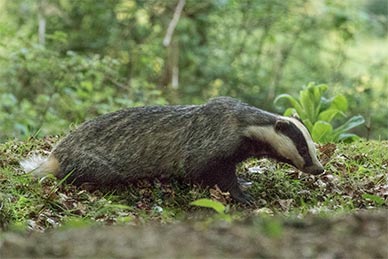
darkness falls
New Forest badgers respond to their modest diet in a number of ways, or rather nature forces their response. Here, they are relatively widespread, but family groups tend to be quite small and the number of births each year fewer than elsewhere.
Perhaps surprisingly, foxes and badgers will often cohabit, or so it seems, raising families at opposite ends of the same tunnel system, with rabbits in residence, too, forming a sort of on-site larder. Fox and badger treat each other with respect, however, but in the event of conflict, the badger is likely to prevail.
Mating takes place throughout the year, but a system of delayed implantation results in consistent late-winter births, usually from the last weeks of January through to early-March. First emergence of the cubs above ground – a real treat for the watcher – is often in April or early May.
New Forest badger setts are often located on a well-drained hillside, at the edge of broad-leaved woodland for cover, and with heath or farmland nearby for use as a feeding area. Active setts are usually betrayed by enormous spoil heaps around a limited number of active entrances, by fresh latrines, and traces of bedding left above ground.
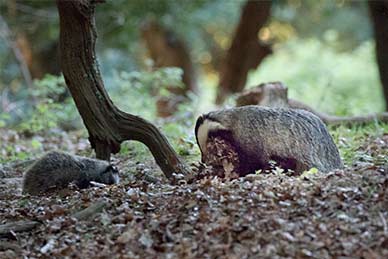
the sett whilst nearby, a cub searches for
foodstuffs amongst the fallen leaves
But unlike their farmland cousins, New Forest badgers often lack access to what presumably are fairly comfortable bedding materials, such as straw, hay and grasses, and must make do with dry leaves and bracken.
Collection of bedding, to human observers at least, entails a somewhat comical-looking process - the badger uses its front legs and paws to gather the material together before tucking a transportable bundle under its chin, and then shuffling backwards towards, and eventually down, a sett entrance that gives access to the sleeping chamber within the tunnel system.
New bedding material dropped along the way and at the sett entrance is usually ignored, whilst old material ejected from the sett during regular 'spring cleans' is left where it falls.
Numerous trips are usually undertaken before sufficient material has been gathered to freshen up the bed, and then the badger can go about its other nightly duties.
In fact, on the whole, the New Forest environment ensures that badgers have quite a tough time.
Further information and a variety of fascinating badger videos
References:
The Natural History of Badgers, Ernest Neal
Badgers: Ernest Neal and Chris Cheeseman
Darkness Is Light Enough: Chris Ferris
Out of the Darkness: Chris Ferris
Eileen Soper's Badgers
Mammals of Britain and Europe: David Macdonald and Priscilla Barrett
More links
Other related links
Search this site
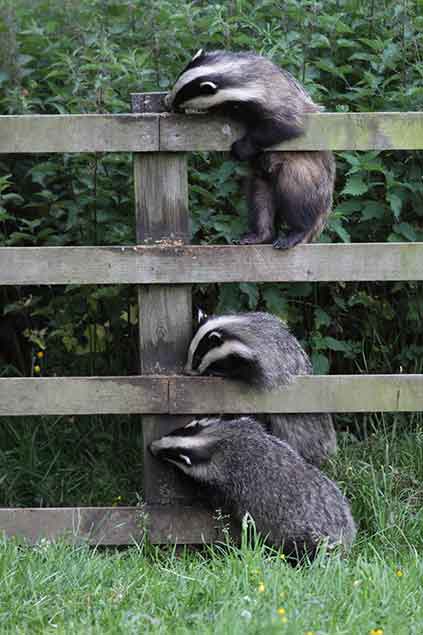
these three quickly discovered peanut butter
placed on fence posts adjacent to their sett
and had little difficulty reaching the treat

Sadly, 58 animals were killed - 35 ponies, 13 cows, 8 donkeys and 2 sheep, whilst a further 32 were injured - 3 pigs, 9 donkeys, 11 cows and 9 ponies.
(Forty-three accidents occurred in daylight, 15 at twilight and 101 in the dark. Twenty-seven accidents were not reported by the driver involved).
Here's just one horrific example - Three donkeys killed in collision with van at notorious New Forest blackspot (Advertiser and Times)
Sika deer continue to engage in rutting behaviour, and will do so until December.
Pigs seek out the remains of the acorn crop.
Beech leaves are transformed into a magnificent mosaic of glorious reds and golds. Other deciduous trees, too, take on an autumnal cloak before their leaves fall.
Dragonflies can occasionally be seen on the wing on bright days early in the month.
December
Foxglove leaves survive the winter at ground level, and offer the prospect of colourful summer blooms to come.
Redwings and fieldfares, autumn and winter visitors, gorge on haws and holly berries.
Great grey shrikes and hen harriers hunt over the heaths and other open spaces.
Honeysuckle by the end of the month often shows welcome signs of new growth.

